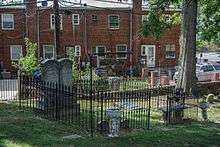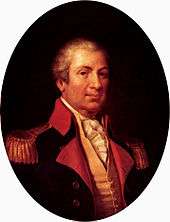Constantino Brumidi

Constantino Brumidi (July 26, 1805 – February 19, 1880) was a Greek-Italian-American historical painter, best known and honored for his fresco work in the Capitol Building in Washington, DC.
Parentage and early life
Brumidi was born in Rome, his father a Greek from Filiatra in the province of Messinia, Greece, and his mother an Italian. He showed his talent for fresco painting at an early age and painted in several Roman palaces, among them being that of Prince Torlonia. Under Gregory XVI he worked for three years in the Vatican.
Immigration and following work

The occupation of Rome by French forces in 1849 apparently persuaded Brumidi to emigrate, having joined the short-lived risorgimental Roman Republic, and he sailed for the United States, where he became a naturalized citizen in 1852. Taking up his residence in New York City, the artist painted a number of portraits. Subsequently, he undertook more important works, the principal being a fresco of the Crucifixion in St. Stephen's Church, for which he also executed a Martyrdom of St. Stephen and an Assumption of Mary. He also executed frescoes at Taylor's Chapel, Baltimore, Maryland.
In 1854 Brumidi went to Mexico, where he painted an allegorical representation of the Holy Trinity in the Mexico City cathedral. On his way back to New York he stopped at Washington D.C. and visited the Capitol. Impressed with the opportunity for decoration presented by its vast interior wall spaces, he offered his services for that purpose to Quartermaster General Montgomery C. Meigs. This offer was accepted, and about the same time Meigs was commissioned as a captain of cavalry.
His first art work in the Capitol Building was in the meeting room of the House Committee on Agriculture. At first he received eight dollars a day, which Jefferson Davis, then Secretary of War of the United States, helped increase to ten dollars. His work attracting much favourable attention, he was given further commissions, and gradually settled into the position of a Government painter. His chief work in Washington was done in the rotunda of the Capitol and included the Apotheosis of George Washington in the dome and the Frieze of American History, which contains allegorical scenes from American history. His work in the rotunda was left unfinished at his death, but he had decorated many other sections of the building, most notably hallways in the Senate side of the Capitol now known as the Brumidi Corridors.
Brumidi's Liberty and Union paintings are mounted near the ceiling of the White House entrance hall.
In the Cathedral-Basilica of Sts. Peter and Paul in Philadelphia, Pennsylvania, he pictured St. Peter and St. Paul. Brumidi was a capable, if conventional painter, and his black and white modeling in the work at Washington, in imitation of bas-relief, is strikingly effective. He decorated the entrance hall of Saleaudo, located at Frederick, Maryland, and listed on the National Register of Historic Places in 1979.[1]
A Brumidi fresco appears behind the altar in St. Ignatius Church in Baltimore, Maryland. Another, of Saint Aloysius Gonzaga receiving communion from Saint Charles Borromeo, hangs over the high altar of St Aloysius Church in Washington, D.C.
In memoriam
Brumidi died in Washington, D.C., and was interred at Glenwood Cemetery. When he was buried, his grave was unmarked. The location of Brumidi's grave was lost for 72 years. It was rediscovered, and on February 19, 1952, a marker was finally placed above it.[2]
Forgotten for many years, Brumidi's role was rescued from obscurity by Myrtle Cheney Murdock.[3]
On June 10, 2008, Congress passed, and on September 1, 2008, President George W. Bush signed, Public Law 110-59 (122 Stat. 2430), which posthumously awarded the Congressional Gold Medal to Constantino Brumidi, to be displayed in the Capitol Visitor Center, as part of an exhibit honoring him.[4]
Gallery
| Wikimedia Commons has media related to Costantino Brumidi. |
 General Henry Knox, first United States Secretary of War
General Henry Knox, first United States Secretary of War Brumidi's fresco Apotheosis of Washington adorns the underside of the dome in the rotunda of the United States Capitol
Brumidi's fresco Apotheosis of Washington adorns the underside of the dome in the rotunda of the United States Capitol Brumidi's Liberty is mounted in the ceiling of the White House entrance hall
Brumidi's Liberty is mounted in the ceiling of the White House entrance hall
References
![]() This article incorporates text from a publication now in the public domain: Herbermann, Charles, ed. (1913). "article name needed". Catholic Encyclopedia. New York: Robert Appleton.
This article incorporates text from a publication now in the public domain: Herbermann, Charles, ed. (1913). "article name needed". Catholic Encyclopedia. New York: Robert Appleton.
- ↑ "Maryland Historical Trust". National Register of Historic Places: Properties in Frederick County. Maryland Historical Trust. 2008-12-14.
- ↑ Clark, Elizabeth G. "Report of the Chronicler for 1952." Records of the Columbia Historical Society. 51/52 (1951/1952), pp. 181-209, 186.
- ↑ Brumidi study of Capitol dome painting to go to Smithsonian Washington Post
- ↑ Pub.L. 110–259
- Wolanin, Barbara A. (1998). Constantino Brumidi: artist of the Capitol. Washington: U.S. Government Printing Office.
External links
- Constantino Brumidi: Il Michelangelo Del Capitol (Italian) - Dossena, Tiziano Thomas, L'Idea Magazine N.24, Vol.II, 2005, New York